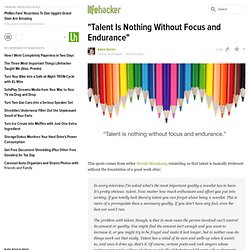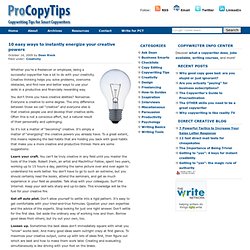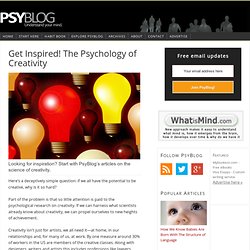

Concentrate, Then Stop Thinking to Generate More Creative Insights. Use "Weird Rules" To Boost Your Creativity. Ten years ago, Stanford professor Robert I.

Sutton wrote a book on how to manage for maximum creativity called Weird Ideas That Work. After studying some of the most innovative people and companies, Sutton concluded that what is right for routine work is consistently wrong for creative work. The best way to manage for creativity, he discovered, is to simply take every tried-and-true management trope and do the opposite. Armed with this epiphany, he laid out his “Weird Rules of Creativity.” In the decade since, many of Sutton’s “Weird Rules” have become, if not standard practice, characteristic of typically innovative companies. Here are a few of my favorite “Weird Rules”: 1. As a manager, one tactic might be to allow an employee to state his case for a project or innovation – then invite team members to dissect it. 2. As Sutton puts it, “Creativity is a function of the quantity of work produced.” "Talent Is Nothing Without Focus and Endurance" I have to disagree in-part.

Focus and endurance make talent. We understand the interplay between genetics and environmental factors enough to know that how we are raised, and the time we spend engaged in a thing, are many times more influential on 'talent' than raw genetics; genetics are not a blueprint, they exhaust their influence as soon as the amino acid chains are formed—the rest is entirely self-governed and highly influenced by the environment.
Society's perception that a person is born with a talent is wrong, and we have to stop accepting that notion in discourse. Want to be talented at something? Start young, with passion, and spend 10,000 hours at it. Nevertheless, thank you for this point; people need to hear that hard work is fruitful. Related: "The Genius in All of Us" -David Shenk. "Weird Rules" Can Help You Boost Your Creativity. Top 10 Ways to Get Your Creative Juices Flowing. I'm a programmer, so my creative is creative thinking, not artistic creative like most people view the term.

I do two basic things. Keep a notepad and a pen on me or nearby at all times. At lest a single A4 sheet and a mini pencil. This way I can jot down anything that comes to mind. I have about six notepads just full of ideas for problem I haven't even encountered yet... but when I do, I know where to look. The notepads are virtual now for easier sorting and searching, but the actual ones are still knocking about in a box. Keep at it. Also, I never, ever stop mid thought. I don't dream, well, I'm one of those wake up and instantly forgot people. and not at all a morning person. When I sit back down to work, I'm better of fresh rather than trying to pick up the genius from the day before. 10 easy ways to instantly energize your creative powers. Whether you’re a freelancer or employee, being a successful copywriter has a lot to do with your creativity.

Creative thinking helps you solve problems, overcome obstacles, and find new and better ways to use your skills in a productive and financially rewarding way. You don’t think you have creative abilities? Creativity Self-Assessment. Creative Thinking Activities and Games. How to be Creative. Trying to make connections?

Here are seven more research-based techniques to increase creativity. “Creativity can solve almost any problem. The creative act, the defeat of habit by originality overcomes everything.” ~George Lois Following on from a previous article on how to be creative, which had a tremendous response, here are another 7 techniques for breaking through a creative block. 1. Conjuring up what might have been gives a powerful boost to creativity. Markman et al. (2007) found that using counterfactuals (what might have happened but didn’t) sometimes doubled people’s creativity. Analytical problems are best tackled with a subtractive mind-set: thinking about what could have been taken away from the situation.Expansive problems benefited most from an additive counterfactual mind-set: thinking about what could have been added to the situation. 2.
People solve many problems analogically: by recalling a similar old one and applying the same, or similar solution. Creativity for the Cautious. The mysterious connection between need for structure and creativity.

Do you like surprises? If you do, it may surprise you to learn that a lot of other people don’t. Our natural ability (or lack thereof) to deal with surprising situations and the uncertainty they generate may have an important role to play in our creativity. Psychologists call our natural way of dealing with uncertainty ‘personal need for structure’. The Psychology of Creativity. Looking for inspiration?

Start with PsyBlog’s articles on the science of creativity. Here’s a deceptively simple question: if we all have the potential to be creative, why is it so hard? Part of the problem is that so little attention is paid to the psychological research on creativity. If we can harness what scientists already know about creativity, we can propel ourselves to new heights of achievement.